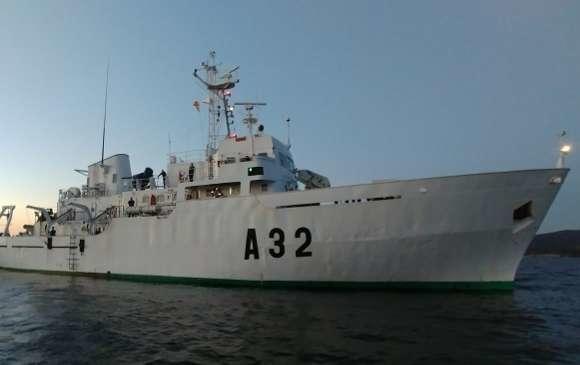Keyword
Cadiz
158 record(s)
Type of resources
Categories
Topics
INSPIRE themes
Keywords
Contact for the resource
Provided by
Years
Formats
Status
-

Cr VERA ref C2945823.987 ICES created form
-

1.- Estimacion de los indices de abundancia (numero y biomasa), de las especies demersales de mayor interes pesquero, asi como de la fauna asociada a ellas. 2.- Determinacion de la distribucion geografica y batimetrica de las diferentes especies. 3.- Obtencion de las distribuciones de tallas de peces, de las capturas asi como de los crustaceos y moluscos de interes pesquero. 4.- Extraccion de otolitos de merluza. 5.- Obtencion de datos biologicos de las principales especies comerciales: estados de madurez, proporcion de sexos 6.- Obtencion de datos oceanograficos.
-

1.- Estimacion de los indices de abundancia (numero y biomasa), de las especies demersales de mayor interes pesquero, asi como de la fauna asociada a ellas. 2.- Determinacion de la distribucion geografica y batimetrica de las diferentes especies. 3.- Obtencion de las distribuciones de tallas de peces, de las capturas asi como de los crustaceos y moluscos de interes pesquero. 4.- Extraccion de otolitos de merluza. 5.- Obtencion de datos biologicos de las principales especies comerciales: estados de madurez, proporcion de sexos 6.- Obtencion de datos oceanograficos.
-

1.- Estimacion de los indices de abundancia (numero y biomasa), de las especies demersales de mayor interes pesquero, asi como de la fauna asociada a ellas. 2.- Determinacion de la distribucion geografica y batimetrica de las diferentes especies. 3.- Obtencion de las distribuciones de tallas de peces, de las capturas asi como de los crustaceos y moluscos de interes pesquero. 4.- Extraccion de otolitos de merluza. 5.- Obtencion de datos biologicos de las principales especies comerciales: estados de madurez, proporcion de sexos 6.- Obtencion de datos oceanograficos.
-

1.- Estimacion de los indices de abundancia (numero y biomasa), de las especies demersales de mayor interes pesquero, asi como de la fauna asociada a ellas. 2.- Determinacion de la distribucion geografica y batimetrica de las diferentes especies. 3.- Obtencion de las distribuciones de tallas de peces, de las capturas asi como de los crustaceos y moluscos de interes pesquero. 4.- Extraccion de otolitos de merluza. 5.- Obtencion de datos biologicos de las principales especies comerciales: estados de madurez, proporcion de sexos 6.- Obtencion de datos oceanograficos.
-

1.- Estimacion de los indices de abundancia (numero y biomasa), de las especies demersales de mayor interes pesquero, asi como de la fauna asociada a ellas. 2.- Determinacion de la distribucion geografica y batimetrica de las diferentes especies. 3.- Obtencion de las distribuciones de tallas de peces, de las capturas asi como de los crustaceos y moluscos de interes pesquero. 4.- Extraccion de otolitos de merluza. 5.- Obtención de datos biologicos de las principales especies comerciales: estados de madurez, proporcion de sexos 6.- Obtencion de datos oceanograficos.
-

1.- Estimación de los indices de abundancia (numero y biomasa), de las especies demersales de mayor interes pesquero, así como de la fauna asociada a ellas. 2.- Determinación de la distribución geografica y batimétrica de las diferentes especies. 3.- Obtención de las distribuciones de tallas de peces, de las capturas as?? como de los crustáceos y moluscos de interes pesquero. 4.- Extracción de otolitos de merluza. 5.- Obtención de datos biológicos de las principales especies comerciales: estados de madurez, proporción de sexos 6.- Obtención de datos oceanograficos.
-

1.- Estimacion de los indices de abundancia (numero y biomasa), de las especies demersales de mayor interes pesquero, asi como de la fauna asociada a ellas. 2.- Determinacion de la distribucion geografica y batimetrica de las diferentes especies. 3.- Obtencion de las distribuciones de tallas de peces, de las capturas asi como de los crustaceos y moluscos de interes pesquero. 4.- Extraccion de otolitos de merluza. 5.- Obtencion de datos biologicos de las principales especies comerciales: estados de madurez, proporcion de sexos 6.- Obtención de datos oceanograficos.
-

Relative index abundance of main commercial species selectivity
-

1.- Estimacion de los indices de abundancia (numero y biomasa), de las especies demersales de mayor interes pesquero, asi como de la fauna asociada a ellas. 2.- Determinacion de la distribucion geografica y batimetrica de las diferentes especies. 3.- Obtencion de las distribuciones de tallas de peces, de las capturas asi como de los crustaceos y moluscos de interes pesquero. 4.- Extraccion de otolitos de merluza. 5.- Obtencion de datos biologicos de las principales especies comerciales: estados de madurez, proporcion de sexos 6.- Obtencion de datos oceanograficos.
 Catálogo de datos del IEO
Catálogo de datos del IEO